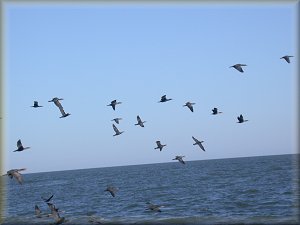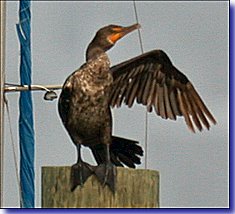Cormorants
|
River Critters: Cormorants |
|


Their genus and species name is Phalacorcoracidae auritus, but they are more commonly known as the double-crested cormorant. The term "double-crested" comes from the two tufts of feathers which the adults have over each eye. The family name Phalacrocorax is Greek for "bald ravens", but the word "cormorant" means "sea crow". They are also known as Shag, Water Turkey, Crow Duck, and Snake Birds.
Because they are a dense bird, they are more suited to swimming than to flight. Watching them take flight, one wonders if they will ever achieve the lift needed to get airborne, as they flap their wings repeatedly against the surface of the water.
In ancient Asia, these birds were often used to assist in fishing. With a band tied to its neck to prevent it from eating its catch and a leash tied to its leg to keep it from escape, the cormorant would be put to work hauling in hundreds of fish a day for its employer.
There is some dispute among observers as to the purpose of their characteristic wing-spreading behavior. Some believe it is to dry their feathers, others believe it is for thermal regulation, while another group tends to favor the notion that it is a social sign, possibly suggesting a successful forage. Whatever the reason, it makes for an interesting display.